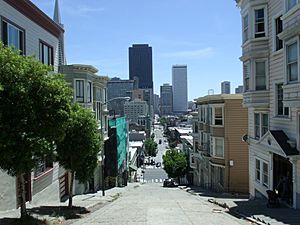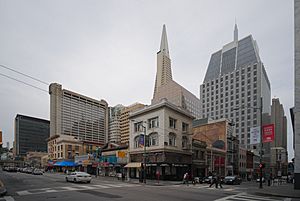Kearny Street facts for kids
Kearny Street is a well-known street in San Francisco, California. It stretches north from Market Street all the way to The Embarcadero. Near its southern end, Kearny Street acts as a border. It separates the Financial District from the lively Union Square and Chinatown areas. As you go further north, the street goes over Telegraph Hill. There is a small break in the street near Coit Tower.
Contents
History of Kearny Street
Kearny Street has a long and interesting past. The Spanish originally named it "La Calle de la Fundacion." This means "street of the foundation." The street's current name, Kearny Street, is thought to come from Stephen Watts Kearny. He was the first military governor of California when it became part of the U.S. Some people also think it might be named after General Philip Kearny. It is sometimes mistakenly linked to a labor leader named Denis Kearney.
First Cable Car Line
A very important event happened at Kearny and Clay Streets. This was the starting point of America's very first cable car line. It was launched by Andrew Smith Hallidie on August 2, 1873. This amazing invention climbed five blocks up Clay Street hill. It went towards Nob Hill.
Kearny Street in the Early 1900s
In the early 1900s, Kearny Street was a very busy place. It ran from Market Street to the Barbary Coast. The street was full of exciting entertainment spots and places to eat. People who followed horse racing and other interesting professionals often visited. On election nights, the street was famous for its torch-light parades and loud brass bands. This made it a very lively part of the city.
Manilatown and the International Hotel
From the early 1900s until 1977, a large Filipino community lived near Kearny and Jackson Streets. This area became known as Manilatown. The International Hotel at 848 Kearny Street was the heart of this community. In the 1920s and 1930s, Manilatown had a population of 20,000 to 40,000 people.
In 1968, the hotel was sold to developers. They wanted to build new commercial properties. The people living there fought hard to stay in their homes. On August 4, 1977, the remaining residents had to leave. The hotel and other buildings were quickly torn down. The land stayed empty for over 25 years. On July 27, 2004, a two-block part of Kearny Street was officially named Manilatown. This honored the history and people of the area.
Protecting Old Buildings
A city expert named John King looked at Kearny Street in 2006. He noticed that it has a mix of tall skyscrapers and older, lower buildings. Many of these older buildings have strong stone fronts. These low blocks still exist because of city efforts in the 1970s and 1980s. The city worked to save older buildings. This stopped the Financial District from taking over everything. This kind of careful planning helps keep a city's unique look.
Famous Spots on Kearny Street
Kearny Street is home to several important landmarks.
- Lotta's Fountain is at Market Street. This is where people gather to remember the 1906 San Francisco earthquake.
- One Montgomery Tower is an office building. It is located on Kearny and Post streets.
- 555 California Street is the city's fourth tallest skyscraper.
- The old Hall of Justice was at Kearny and Clay Streets. The Hilton San Francisco Financial District hotel is there now.
- Portsmouth Square was the original town square of Yerba Buena.
- Coit Tower sits at the top of Telegraph Hill.
Other Uses of the Name
- "Kearny Street" is also the name of a song. It was written by American composer Rod McKuen.



